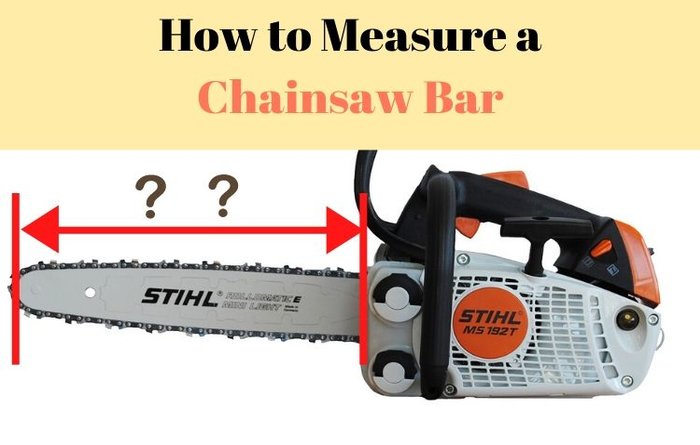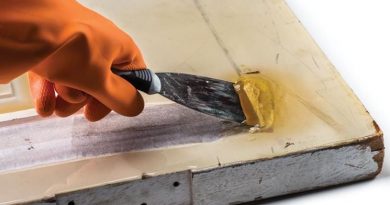How to Measure a Chainsaw Bar [Quick & Easy]
Not everyone knows how to measure a chainsaw bar. Chainsaw bars are available in limitless combinations of sizes, types, and features.
How do you measure the chainsaw bar? Where do you measure it from?
The actual length of the chainsaw bar, i.e. the tail-tip distance, is not a valid parameter for measuring a chainsaw bar.To measure a chainsaw bar, take into account the cutting length , the useful length of the bar, which is equal to the part of the bar that comes out of the chainsaw body.
It is the cutting length of a chainsaw bar, in addition to its power, that makes you think what use you can make of a certain chainsaw: if you can use it only for pruning or if you can cut large trunks.
As you can see in the Efco catalog , for example, the bars for pruning chainsaws have shorter cutting lengths (25-30 cm) than normal or carving bars. Normal chainsaw bars, on the other hand, range from 35 to 76 cm in cutting length.
Small chainsaws , such as the MT 3500 S , being suitable for small gardening and DIY projects, have chainsaw bars with a cutting length of 35 and 41 cm with a fixed spool.
The professional saws , such as the model 162, which instead are designed for large-scale works and , power they need chainsaw bars between 38, 41, 46, 51, 61 and 64 cm with both replaceable spool or fixed , both with reinforced toe .
Finally, if your chainsaw is a cross between small and professional ones such as the MT 5200 medium power chainsaw, the bars you can use are 38, 41, 46, and 51 cm with replaceable or fixed return spool.
How to Measure a Chainsaw Bar(Blade) Step by Step
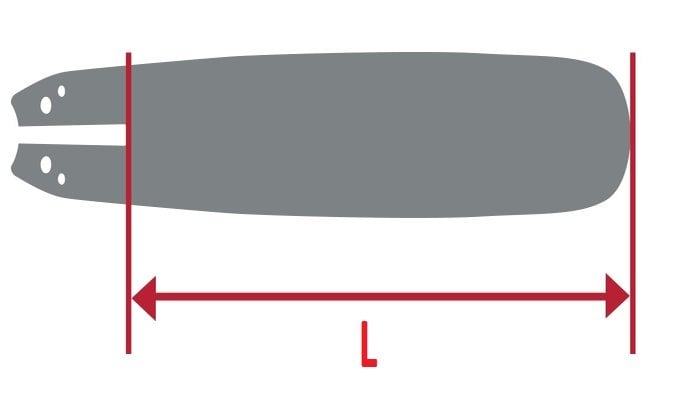
Removing the chain and blade from a chainsaw is the best way to get the most accurate measurement of your chainsaw’s bar.
With a basic knowledge of chainsaw tools and parts, this task is relatively simple and will not take too long to complete. This will also allow you to inspect the chainsaw blade for damage so that you can purchase a new bar if it is needed.
Step 1. Remove the chainsaw housing which covers the blade
Remove the two nuts screwed into the housing located near the handle with a set of sockets. These two nuts secure the housing to cover the blade. Once you have removed the nuts, remove the housing. Behind the housing you will see the entire drive bush, the chain and the saw bar.
Step 2. Release some tension to pull the chain from the bar
Locate the tension wheel just inside the chain saw bar. Use a flathead screwdriver and turn the screw to the left to release some of the tension and pull the chain away from the grooves on the bar. Remove the chain from all the grooves on the bar until you reach the drive sprocket.
Step 3. Remove the chain from the chainsaw bar
Pull the chain on the drive sprocket to remove the chain completely. The drive gear is a wheel located under the handle.
Step 4. Check to see if the chainsaw bar needs replaced or repair
Remove the blade or bar once the chain is removed. When you remove the bar, you can check and see if the bar needs repair or needs to be replaced.
Step 5. Measure the chainsaw bar
Place the blade on a flat work surface and measure the bar or a blade with a ruler. Measure the length of the bar from start to finish or take your blade to a local hardware store and they can get a new blade or measure the one you have for you.
What is the best way to measure a chainsaw bar?
To measure the bar of the chainsaw is quite simple to do. Just put the measuring tape at the end of the bar against the frame and measure the bar down to the tip of the blade.
Blade and the bar are two terms that are both used to indicate the same item. This is the blade that extends from the chainsaw engine casing and carries the chain which is what makes the cut for you.
Manufacturers had the kindness to standardize the chainsaw blade length in two inch increments. Most common sizes are 16, 18 and 20 inches, although the range is 10 to 42 inches!
When measuring the blade, round to the nearest measurement 2 inches if necessary.
What do the numbers mean on a chainsaw bar?
Therefore, the characteristics of the attachment plan of the chainsaw blade are essential in the choice of the chainsaw bar and are summarized by the last letter and the last 3 numbers of the bar type identification code, for example “K095”. Now let’s explain better:
For example, for the Efco 162 professional chainsaw, the manual recommends several types of bars , including the 168RNDK095 type.
What does this identification chainsaw bar code mean (each type of bar has its own code)?
- 16 = bar cutting length in inches (16 “= 41 cm)/ (not the total length, but the usable working length)
- 8 = width of the guide, which coincides with the thickness of the chain (8 = .058 “= 1.5 mm) / or drive link width
- RN = bar type (RN = Oregon Power Match® bar with replaceable tip)/ bar model
- D = number of teeth and chain pitch (D = 3/8 “pitch with 9/11 teeth)
- K095 = type of blade with its characteristic measures and shapes / blade connection (rear part of the sword that is used in the machine unit for fastening)
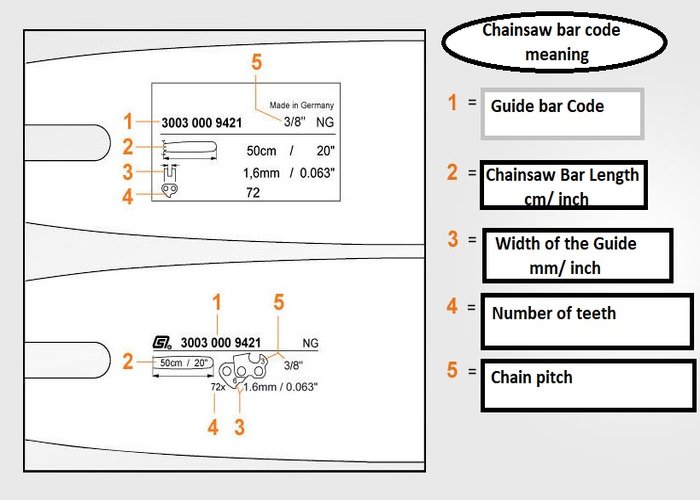
| Bar length | Guide width in inches / mm | Bar type | Chain division blade shape | Blade type |
| 10 “= 25 cm 11″ = 28 cm 12 “= 30 cm 13″ = 33 cm 14 “= 35 cm 15″ = 38 cm 16 “= 40 cm 17″ = 43 cm 18 “= 45 cm 19″ = 48 cm 20 “= 50 cm 21″ = 53 cm 22 “= 55 cm 23″ = 58 cm 24 “= 60 cm 25″ = 63 cm 26 “= 65 cm 27″ = 68 cm 28 “= 72 cm 29″ = 74 cm 30 “= 76 cm 32″ = 78 cm 33 “= 81 cm 36″ = 90 cm | 0 0.050 “ 1.3 mm 3 0.063 “ 1.6 mm 4 0.043 “ 1.1 mm 8 0.058 “ 1.5 mm | MP SL RN AT LA GP SP DG SD ML SX | A 1.4 “ B narrow D 3/8 “narrow E 3/8 “(chain 90/91) F 0.404 “bulbous G 0.325 “bulbous H 3/8 “bulbous | A016 A041 A061 A064 A074 A089 A095 A111 A129 A218 A318 B004 B083 B100 D009 D010 D024 D025 D029 D033 D176 D196 D276 E031 E086 E099 K041 K095 K153 F014 M015 |
How to Measure a Stihl Chainsaw Bar?
One of the parameters of the guide is its size. Typically, chainsaw guide rail size is indicated in inches, sometimes in centimeters.
We recommend using the size in inches. The most commonly used chainsaw bar sizes are 11 ″, 12 ″, 13 ″, 14 ″, 15 ″, 16 ″, 18 ″, 20 ″, 21 ″, 22 ″.

The smaller chainsaw bar size is used for simpler jobs. For example, a chainsaw with an installed bar of 11-13 inches is used as a delimber, and is also used to cut small non-thick boards.
This chainsaw bar is small and allows you to accelerate the circuit at high speed, which allows you to perform work quickly.
The most used and universal chainsaw bar size is 14-16 inches. Such bar allow both the production of firewood and the use of a chainsaw (electric saw) as a delimbers.
Chainsaw bar 18 – 22 ″ are used for cutting thick trees when harvesting firewood. Such chainsaw bars are used in semi-professional, professional and powerful saws.
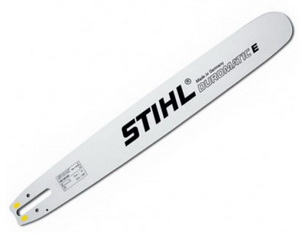
When choosing a bar for a chainsaw, you should pay attention to the shape of the bar itself.
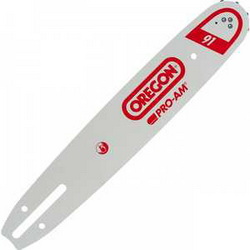
For amateur saws, narrow and flat (low profile) chainsaw bar are used. Such chainsaw bars do not give a back strike and are very safe, which beginners will appreciate.
There are also lightweight chainsaws for chainsaws. These bars have a reduced weight, which allows you to work and control the chainsaw canopy, as well as on the roof of the house.
The lightweight saw bar consists of 2 steel plates that are internally fastened with polyamide. There is another group of saw bars – with interchangeable heads.
This is necessary for chainsaws operating in heavy duty, when the wear rate of mechanisms increases. For domestic needs, this form of chainsaw bar is not needed.
One of the important parameters of the saw bar is its shank (fastening). Each manufacturer has its own bar mount. Therefore, sometimes the chainsaw bar from one saw may not fit into another.
How do you Measure a Husqvarna Chainsaw Bar?
Step 1. Disconnect the spark plug
Turn off the chainsaw and remove the spark plug wire from the outlet itself. Grasp the boot covering the spark plug and remove the wire by gently pulling on the boot. This prevents any possibility of accidental starting of the chain saw.
Step 2
Butt the end of a measuring tape against the housing where the bar emerges.
Step 3
Stretch the strip at the opposite end of the bar and read the measurement at the end furthest from the end of the bar.
Step 4
Round the measurement to the nearest inch. For example, if you measured 15 7/8 inches from the cutter housing, you have a 16 inch chainsaw.
Step 5
Remove the nuts securing the housing to the body of the chainsaw using a socket and ratchet.
Step 6
Pull the cover completely, exposing the entire bar of the chainsaw.
Step 7
Stretch the tape measure from one end of the bar to the opposite end. This measurement is the actual size of the chainsaw bar, which is usually 2 to 3 inches larger than the chainsaw measurement you took in steps 1 to 4.
Find the size of the chain on the chainsaw blade

A quick and easy way to get information about your chainsaw chain is to look at the lower end of the bar .
In fact in many chainsaw bar models there are written:
- the length of the bar;
- the number of links;
- the step of the chain;
- the thickness;
- a reference (not mandatory) corresponding to the chain recommended by the manufacturer for this chainsaw.
You can obviously choose a brand other than the manufacturer’s. To do this, however, the number of links, the pitch of the chain and the thickness must be the same as the chain to be replaced .
Bear in mind that sometimes these indications are not necessarily written on the guide bar but can be found on the tool instructions or on the packaging of the chainsaw chain.
Chainsaw chain chart table
Length of the chain guide
The size of the chain guide varies between 11 cm and 120 cm depending on the model and is proportional to the power of the engine.
Ideally, it should be equal to or greater than the diameter of the trunk you want cut off.
Be careful however ,the longer a guide, the heavier the chainsaw will be to carry due to the weight of its guide, its chain and above all, its engine which will then be more powerful.
For non-professional use, a bar length between 35 and 50 cm is generally sufficient to carry out the majority of cutting work (cutting).
The length of the chainsaw bar
The length of the chainsaw bar or guide will depend on the power of the engine of your chainsaw, in fact you will have to choose a shorter guide if your engine is less powerful. Here are some numbers to help you:
| Chainsaw Type | Power(Watt) | BAR LENGTH (INCHES) |
| Electric corded chainsaw | 750 – 2500 | 13.7 ” – 17.7 “ |
| Electric cordless chainsaw | 500 – 1500 | 4″ – 11.8″ |
| Gas Chainsaw | 1000 – 2500 | 13.7 ” – 17.7 “ |
| Gas Chainsaw | 2000 – 7000 | 15.7″ – 43.3″ |
The cutting length of the chain bar
The chainsaw chains are adapted to the length of the bar of your chainsaw.
Warning! The length of the chainsaw bar always corresponds to the cutting length and not the total length of the blade. It must therefore be measured from the casing of your machine (Only the part of the guide that protrudes from the chainsaw).
For example if it is indicated on the notice or the box of the chain of chainsaw that the guide measures 45cm, it is that the guide makes a cut of 45cm, in reality the total length of the guide can be 50 or 55cm.
All the information that has just been communicated to you can be engraved on the chain guide of your chainsaw. Otherwise, refer to the user manual.
Maintaining your chainsaw chains is also very important.
So that they do not wear out too quickly, we advise you to sharpen them regularly. For this, you can use round sharpening files.
Care must be taken to respect the diameter of the file, in particular according to the pitch of the chain:
- Ø4mm for chains in steps of 3 / 8LP
- Ø4.8mm for chains in .325 pitch
- Ø5.5mm for chains in steps of 3/8 and .404
If you have a large number of chainsaws, we recommend that you sharpen them with our semi-professional electric sharpener or our professional electric sharpener. You will find there a considerable time saving compared to the files of sharpening.
When to replace the chainsaw bar?
The chainsaw bar wears more in the areas that you use most to cut, usually the lower edge: if you periodically turn the bar both shoulders wear out evenly.
With use, burrs are created on the bar guides : they must be filed , otherwise they cause uneven advancement of the chainsaw and premature wear of the chain and the guides themselves.
Always with the file, equalize the two sides of the groove if they have differentiated wear, that is, different heights.
During the useful life of the bar, it is normal for the depth of the sliding guide to decrease slowly, in case of excessive or uneven wear , we recommend replacing the bar.
To see if the chainsaw bar needs to be changed follow this steps:
- Place the chainsaw on a flat surface and place your finger on the chain , if this “swinging” heavily it’s time to change the blade of the chainsaw (always wear cut-resistant gloves when handling the chain).
- Align a ruler between the bar and the external side of the teeth (i.e. the cutting segments) of the chain: if a gap is created, the guide bar is in perfect condition, otherwise it is worn and must be replaced.
To preserve the chainsaw bar in good shape for a long time, you can still follow some precautions, especially when you work remember to:
- Check the chain tension before and after making some cuts (to avoid abnormal wear of the tracks)
- Adjust the flow rate of the lubricating oil according to the type of wood to be cut (to avoid overheating of the guides at the points of greatest friction with the drive links)
- Regularly and scrupulously sharpen the teeth of the chains (reduces the abnormal wear of the tracks and promotes a clean and precise cut)
- Always cut straight and do not push the chainsaw sideways: in this way keep the grooves as intact as possible and do not deform the bar.
- Use the chainsaw blade only for cutting and not, for example, as a hammer, lever or tree-felling wedge.
How to choose the chainsaw bar
The chainsaw blades are not all the same: if you need to replace the chainsaw bar, first follow the instructions in the chainsaw user’s manual and select the alternative from those approved by the manufacturer.
Why is it important to follow the manufacturer’s recommendations? For 2 reasons:
- The attachment surface of the new bar must be compatible with the chainsaw cover.
- Only bars and chains for which your chainsaw is approved must be mounted : otherwise, the warranty is no longer valid and, for any eventuality, the manufacturer no longer has any responsibility.
We said that the attack plan of the bar – that is, the tail – must be appropriate because, compared to the chainsaw, they must match:
- the sliding buttonhole and the studs in which it is to be inserted.
- The chain tensioner pawl and the hole for the chain tensioner in which it is housed
- The oil outlet hole on the bar
Can I use any blade on my chainsaw?
Clearly: no
A suitable blade connection is provided for each chainsaw, which often fits different chainsaw models from the same manufacturer, some even models from different manufacturers.
The following parameters must be considered when using the blade:
- Rails with deflection stars must have the appropriate pitch for the chain drive sprocket (at 3/8 “there is also a difference between the hobby and the professional chain)
- Groove width
- The width and length of the slot in the middle of the rail at the beginning of the blade
- Location of the chain oil supply holes
- Location and size of the hole for the bolt of the sword clamping device
- Sword length
- Contour of the rail (depending on the application)
- Radius at the tip of the rail (the smaller it is, the lower the risk of kickback, but the greater the chain wear or elongation due to the larger kink angle (polygon effect) and the other way round)
Thanks to these pieces of information, you can easily know how to measure a chainsaw bar. The chain reference will help you quickly find the necessary chain model in the same brand as the chainsaw guide/bar.
Can you put bigger bar on chainsaw?
The instructions for your saw should indicate the bar sizes that you can use. It is not recommended to install a chainsaw bar longer than indicated by the manufacturer, because this affects the engine speed.
The longer the chainsaw bar, the more the engine spends power to rotate the crankshaft to accelerate the chain, and this affects engine wear. This is the most important rule to follow.
How to measure a chainsaw bar
If you are looking for a spare bar for your chainsaw, you need to determine its bar size. You will measure the used length of the bar. To determine the required length of the chainsaw bar, measure it from the front end to the cutter closest to the saw body. Round this measurement to the nearest even number in inches.
For example, a part that measures 18 3/4 will actually have a named length of 20 “.
You can then find a new part with a length of 20. You can also enter this dimension in the Bar and Chain Calculator to find the correct bar replacement for your chainsaw.

